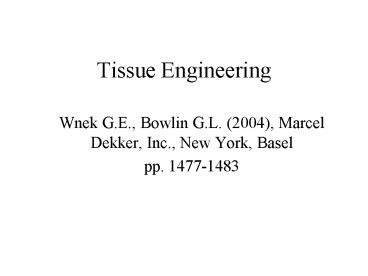Tissue Engineering - PowerPoint PPT Presentation
1 / 21
Title:
Tissue Engineering
Description:
Tissue Engineering. Wnek G.E., Bowlin G.L. (2004), Marcel Dekker, Inc., New York, Basel ... Drawback: Week mechanical resistance of the obtained substitutes. ... – PowerPoint PPT presentation
Number of Views:76
Avg rating:3.0/5.0
Title: Tissue Engineering
1
Tissue Engineering
- Wnek G.E., Bowlin G.L. (2004), Marcel Dekker,
Inc., New York, Basel - pp. 1477-1483
2
(No Transcript)
3
(No Transcript)
4
Introduction
Tissue engineering is a revolutionary addition to
to the therapeutic armamentariumum of medicine
The intrinsic problem of transplantation is the
chronic shortage of tissue organs.
Tissue engineering allows the hope of of a
regular creation of spare parts of the human body.
Tissue engineering is a most significant approach
to reconstruct, replace, or repair organs in a
way that could not be foreseen 25 years ago.
5
Saints Cosmas and Damian performing a miraculous
transplantation
Oil painting on panel 168 x 133 cm., attributed
to the Master of Los Balbases, Burgos, Spain, c.
1495
6
Reconstructive surgery In 1970s the development
of microsurgery allowed distant tissue transfer
and reimplantation (vascular grafts and
prosthetic articulation).
Tissue engineering is remarkably
multidisciplinary, bringing together cell and
molecular biologists, biochemists , engineers,
pharmacologists, physicians, ..etc.
Tissue engineering does open radically new
chapter in reconstructive medicine, for it is now
deemed possible to reconstruct in the laboratory
human living tissues and organs for in vivo, ex
vivo, and even in vitro applications.
7
The aim of Tissue engineering is to obtain grafts
for in vivo applications. The biological and
mechanical functions are of utmost importance.
Biological functions cell therapy Mechanical
functions tissue templates.
8
Tissue-engineered substitutes are
three-dimensional reconstructions that can be
implanted into the human body, leading to rapid
host implantation and acceptance.
The substitutes must have at least minimal
biological and mechanical functions for such
reparative role.
9
Historical perspective
Tissue engineering has been considered one of the
most influential new technologies for the future
biomedicine.
- The development of tissue engineering can be seen
as heaving two phases - The phase of exponential development and
potential application. Is still continuing to
evolve. - The phase brought about a flury of discoveries
about stem cells.
Stem cells S.c. had been known for many
years. Embrionic S.c. Adult S.c. were found to be
much more ubiquitous and to have more lineage
plasticity than previously thought. (since 1998)
10
(No Transcript)
11
Approaches to tissue-engineering substitutes
Three different approaches to tissue-engineered
substitutes
Fig.2 p.1478 (www.dekker.com)
1. Seeding of cells into various gels (collagen
gels, fibrin and other component) Eugene Bell. It
was shown that the incorporation within the depth
of these matrices with various types of cells was
possible.
The true integration of cells into gels allowed
them to reorganize the surrounding matrix.
Drawback Week mechanical resistance of the
obtained substitutes. The structural integrity
may be sufficient for skin, but not so for
substitutes in vascular or orthopaedic systems.
This problem has been addressed with glycation
and magnetic alligement of the collagen fibers.
12
2. The seeding of cells into scaffolds
Natural
Synthetic
The cell thrive in the porous material and
secrete various amount of extracellular matrix
depending on their nature. (developed by Robert
Langers group MIT).
Sponge-like structures from mainly collagenous
materials (E. Kotáková, L.Oceretna, the group
from TUL).
Synthetic scaffolds PGA (Poly(glycolic acid)).
There have been countless modifications and
additions to the different types of synthetic
materials used over the last decade in this
approach.
13
(No Transcript)
14
The obvious advantage of the scaffold approach is
the immediate creation of a three-dimensional
structure that already has significant structural
properties.
Drawback The intrinsic nature of most of these
polymers, which are suture materials, entails
slow degradation with an ensuing lowering of pH
of surrounding tissues. This leads to a slow but
rather protracted low-level inflammatory process.
Many groups are therefore attempting to alter the
chemical nature of these biomaterials to inhibit
this inflammatory process.
15
3. LEOX group (Quebec, Canada)
In this approach various types of cells, mostly
of mesencymal origin, are grown in such a fashion
within a culture flask that they literally
embedded themselves in their very oven
extracellular matrix.
Among many factors, the addition of sodium
ascorbate allows the significant appearance of
the various components of the extracellular
matrix.
These sheets are than either stacked or rolled to
obtain various tissue substitutes.
The re-creation of a totally biological vascular
substitute.
16
The main advantage The absence of extraneous
collagens and any synthetic material.
Drawback This approach is time consuming.
17
Critical integrative aspects of tissue engineering
Two of these critical aspects, namely
Vasularization and inervation, have not received
all the attention they deserve.
Less important for grafts with nearly exclusively
mechanical function such as an aortic synthetic
graft or hip prosthesis.
- Vascularization
The approach of stimulating the ingrowths of
blood vessels into solid organs has not been
successful. Such organs rapidly, within hours or
even minutes, demanded blood irrigation for
survival and proper function.
18
(No Transcript)
19
Skin schaffolds (LOEX group) composed of
combination of dermal layer fibroblasts and
endothelial cells in such a fashion that a
capillary-like systém was reconstructed.
20
(No Transcript)
21
(No Transcript)































